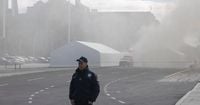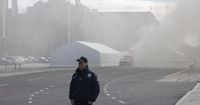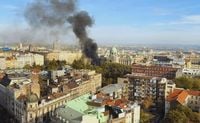In the heart of Belgrade, tension erupted into violence on Wednesday morning, October 22, 2025, as a fire and shooting broke out at a camp hosting loyalists of Serbian President Aleksandar Vucic. The incident, which left one person seriously injured, has sent shockwaves through a nation already simmering with political unrest and has reignited fierce debate over the state of democracy and protest in Serbia.
The camp, colloquially known as "Caciland," is a cluster of white tents set up in March 2025 in and around the park and public square near the Serbian parliament building and the president’s office. Its purpose? To act as a sort of human shield against the persistent anti-government protests that have roiled the capital for months—protests that many see as the most serious challenge to Vucic’s rule in years, according to reports from the Associated Press.
Eyewitnesses described a chaotic scene as a 70-year-old man approached the camp and fired shots toward one of the tents, sparking a fire that quickly spread. Footage captured the fire breaking out immediately after a series of popping sounds—gunfire, unmistakably—sent police officers ducking for cover and drawing their own weapons. Officers shouted for people to take cover as the situation escalated rapidly.
Police moved swiftly to arrest the alleged shooter, who now faces charges of attempted murder, causing public danger, and illegal possession of weapons. According to authorities, the man confessed upon arrest that he wanted police to kill him and that he was "annoyed by the tents" occupying the Belgrade city center. President Vucic, addressing the nation in a hastily arranged press conference, did not mince words. He described the attack as an "awful terrorist attack," adding, "it is my political judgement because the man used firearm with an aim to cause public danger and with an undoubtful political motive." Vucic’s comments, as reported by the Associated Press, underscored the political undertones of the incident.
Health Minister Zlatibor Loncar confirmed that one person suffered serious injuries in the attack, stating the victim was shot by a "man who thinks differently." Loncar did not elaborate further on the victim’s condition or identity, but the gravity of the incident was clear. The attack has cast a long shadow over the capital, where political divisions have only deepened in recent months.
The timing of the violence is particularly significant. The incident occurred just days before a major rally planned for November 1, 2025, in Novi Sad. This rally will mark the first anniversary of the catastrophic train station canopy collapse that killed 16 people on November 1, 2024—a tragedy widely blamed on corruption and negligence in public construction projects. The disaster sparked massive, youth-led protests against what many describe as Vucic’s increasingly authoritarian rule, and has become a rallying point for a new generation of activists in Serbia.
Since the collapse, anti-government protests have become a fixture in Serbian life. Gen Z protesters, in particular, have been at the forefront, demanding accountability and calling for early parliamentary elections—demands that President Vucic has so far refused to meet. The camp at the center of Wednesday’s violence was erected as a direct response to these protests, a physical barrier between the president’s loyalists and his critics. As tensions have mounted, the government has launched what many allege is a campaign of intimidation against protesters, including reports of arbitrary arrests and police violence.
The political atmosphere in Serbia is, to put it mildly, combustible. President Vucic has repeatedly accused anti-government demonstrators of fomenting violence, even as their protests have largely remained peaceful. "It was a question of time before this would happen," Vucic said at his press conference, suggesting that the attack was the inevitable result of what he characterized as a climate of hostility whipped up by his opponents. "There were countless calls for this (shooting)," he asserted, further stoking controversy about responsibility and blame.
Pro-government tabloids wasted no time in accusing opposition figures of being behind the attack, though police have not released evidence linking the shooter to any organized political group. The suspect’s own statements—his annoyance with the tents and apparent desire for a fatal confrontation with police—suggest a more personal, if politically charged, motive. Nevertheless, the event has become a flashpoint in the ongoing struggle between Serbia’s government and its critics.
For many in Serbia, the events of October 22 are emblematic of a broader crisis. The white tents of Caciland are more than just a political encampment; they are a symbol of the deep divisions that now define Serbian society. On one side stand the loyalists of President Vucic, determined to defend his administration against what they see as destabilizing forces. On the other are the protesters, galvanized by tragedy and united in their demand for change—especially among the country’s youth, who have been energized by the memory of the Novi Sad disaster and by a desire for greater transparency and accountability in government.
Authorities have promised a full investigation into the shooting and fire, but many in the opposition remain skeptical. They point to a pattern of government crackdowns on dissent, from the reported use of arbitrary arrests to allegations of excessive police force. The coming days are likely to see renewed protests and heightened security, especially as the November 1 anniversary approaches. The rally in Novi Sad is expected to draw thousands, with organizers promising to keep the focus on justice for the victims of the canopy collapse and on the broader struggle for democratic reform.
As Serbia stands at this crossroads, the question on everyone’s mind is what comes next. Will the violence in Belgrade serve as a wake-up call, prompting dialogue and de-escalation? Or will it harden the lines between government and opposition, setting the stage for further unrest? For now, all eyes remain on the capital, where the white tents of Caciland continue to flutter in the autumn wind—a stark reminder of a nation at odds with itself.
The events of October 22 have left Belgrade shaken but not broken, and the outcome of this latest crisis may well shape the future of Serbian politics for years to come.


